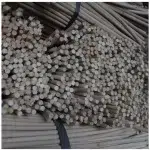Rattan (Calamus spp.) is a type of perennial climbing plant that falls under the Arecaceae family (Palmae). Rattan grows by climbing or winding around large trees in tropical forests at elevations of up to 1200 meters above sea level. In Indonesia, rattan has long been utilized by communities as a raw material for crafts and household furniture. To ensure sustainable utilization, it is important to have a deep understanding of the Rattan’s Life Cycle.
Rattan Growth
The life cycle of rattan begins with seeds naturally dispersed and germinating into seedlings. Rattan grows slowly in the first two years.
Germination Stage
Rattan seeds are ellipsoid, with a length of 1.5-2 cm. The germination of rattan seeds takes 15-60 days. Factors affecting germination include a temperature of 25-35°C, air humidity of 60-80%, and fertile and loose soil.
The emerging young shoot is called the plumule. The plumule will grow into a stem and leaves, forming a seedling about 30-50 cm tall within 2-4 months.
Growth Stage
In the third year, the seedling transforms into a stem that is 2 meters tall with a diameter of 1-2 cm. The growth rate starts to increase drastically, reaching up to 25 meters by the 5th to 6th year.
Upon reaching maturity, the stem’s diameter reaches 5-10 cm with a segment length of 50-60 cm. The mature rattan stem can have 100-150 segments.
Maturation Stage
Rattan is ready for harvest at the minimun age of 2-3 years. The stem’s bark will harden and turn dark brown. Oval-shaped fruits with a diameter of 3 cm form in the leaf axils. The fruit can be singular or in clusters of 2-15 seeds.
One mature rattan plant can produce 40-50 fruit bunches per year. Each bunch contains 1-3 seeds that will scatter and grow into new plants.
Population Maintenance
After harvesting, the land is maintained by clearing weeds to optimize the growth of new shoots. Replanting is encouraged to preserve the population. Thinning is carried out to prevent rattan from inhibiting each other’s growth.
That’s the rundown on the Rattan’s Life Cycle and the techniques for harvesting and conservation. This information is crucial for sustainable cultivation and utilization of rattan.






